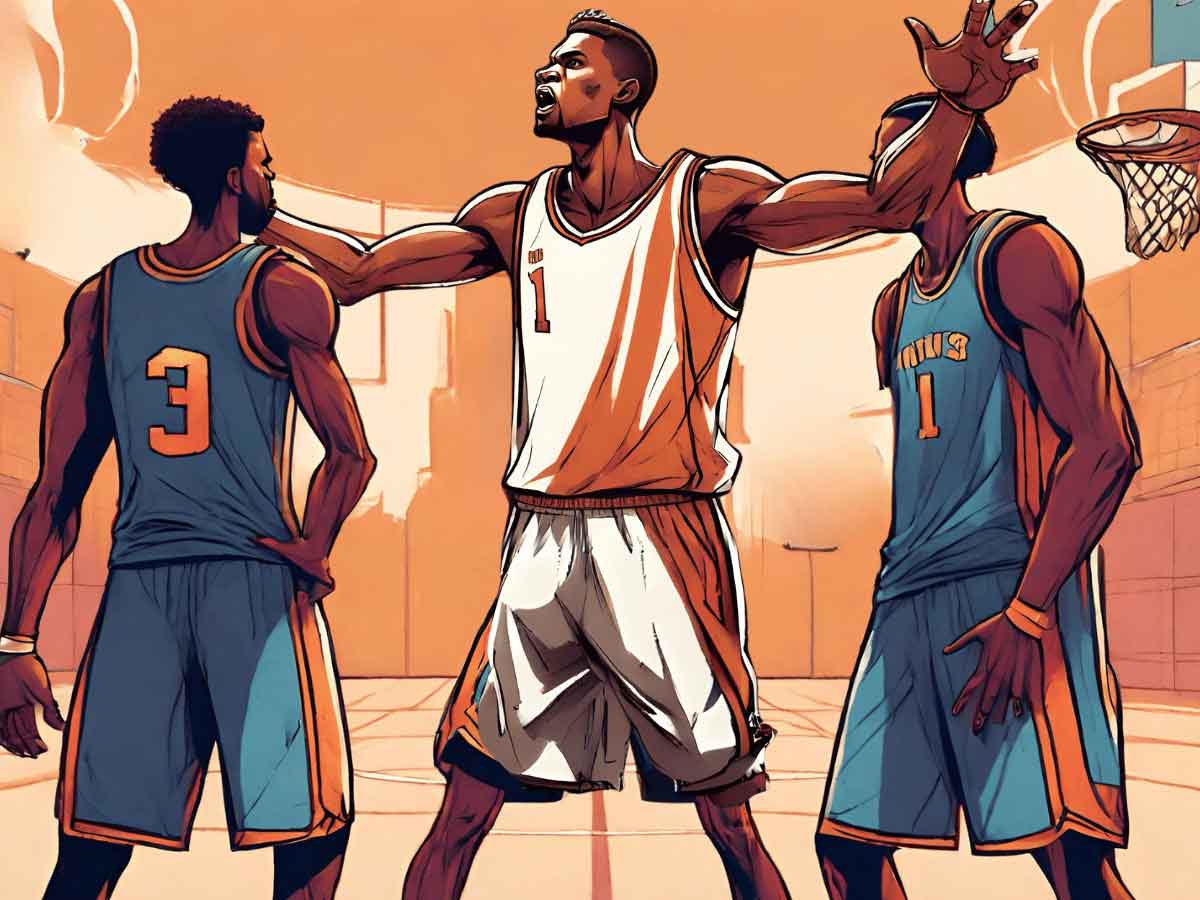In basketball, the back screen plays a big role in many teams’ offensive strategies. Imagine a player sneaking up behind an opponent to block them (that’s the screen), creating a clear path for a teammate to move and get the ball. This move can be huge for setting up shots and scoring points.
Key Takeaways:
- A back screen is when a player blocks an opponent from behind, helping a teammate get open.
- By using back screens, players can find better open spots near the rim to score.
- To pull off a back screen, players need good timing, the right position, and to work together well.
This guide takes you from the basic ‘how-tos’ of the back screen in basketball to more advanced tips. Whether you’re just starting or wanting to get better, understanding the back screen is one way to being a more valuable player.
The Basics of a Back Screen
What is a Back Screen?
Think of a back screen in basketball as a surprise move. One player sneaks up behind the defender (the person watching their teammate) and stops about a foot away, becoming a human barrier. The teammate then quickly goes around this human barrier, escaping their defender.
Also often referred to as a rip screen, this sneaky tactic often leads to a better spot on the court or sometimes an open shot at the basket. That’s why it’s such an instrument component to many teams’ offensive strategy.
What are the Benefits of a Back Screen?

A back screen is a favorite in many offensive plays because it’s great for:
- Creating open shots: When a player without the ball needs to get open for a shot, a back screen can free them up.
- Often leads to shots close to the basket: Back screens are generally used to get a player open for an easy layup, dunk, or alley-oop.
- Disrupting defense: This move can mix up the other team’s defensive tactics, making it hard for them to stick to their plan. It can also force the defense to switch, creating a mismatch opportunity.
- Surprise element: The defender getting screened doesn’t see it coming. This element of surprise can shake things up and give your team an advantage.
TRIVIA:
Which legendary basketball player is known for effectively using back screens to create game-changing plays?
Clue 1: This player has won multiple NBA championships.
Clue 2: Known best for his exceptional shooting, he changed the way the three-point line is utilized in the game.
Clue 3: He’s played his entire professional career with the Golden State Warriors.
Scroll to the bottom for the answer.
When is a Back Screen Most Effective?
A back screen works best in certain situations, such as:
In a Set Offense or Quick Hitter Inbounds Play
A back screen shines in a planned offensive strategy. It works smoothly in set plays where each player’s movement is predetermined. It’s also great in quick hitter inbounds plays when a team has limited time left to score.
For Lob Passes, Layups, and Close Shots
If you’re looking to make a high pass (lob pass), a quick layup, or a shot near the basket, a back screen is your go-to move. It clears the way straight to the basket, making these shots easier.
Against Tight Defense
When an opponent is guarding a player closely, they’re more susceptible to getting caught up on a back screen. A back screen can create just enough space for that player to get free.
Screening from the Block Area
A common back screen scenario is when the screener starts from the block area (near the basket) and sets a back screen for a teammate near the three-point line. This opens up space near the basket for the teammate to cut toward the basket.
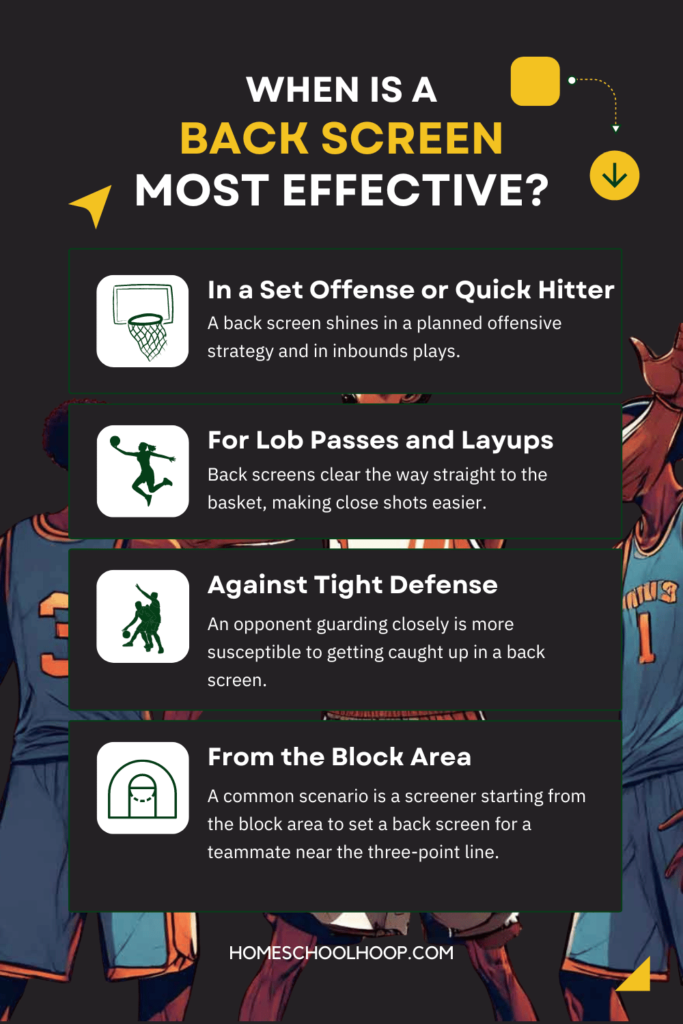
Executing the Perfect Back Screen
Setting Up the Back Screen
To make a basketball back screen work, start with these screening techniques:
- Choose the Right Moment: The player setting the screen (the screener) needs to pick a time when their teammate is near the free throw line or three-point line. This is where they can really use the screen to their advantage.
- Move into Position: The screener should set themselves squarely behind the defender they’re screening, leaving about a foot of space to avoid an illegal screen call.
- Stand Firm: Once they’re in place, the screener must stay still. Leaning or extending their limbs could lead to a moving screen foul, and they need to be a solid barrier.
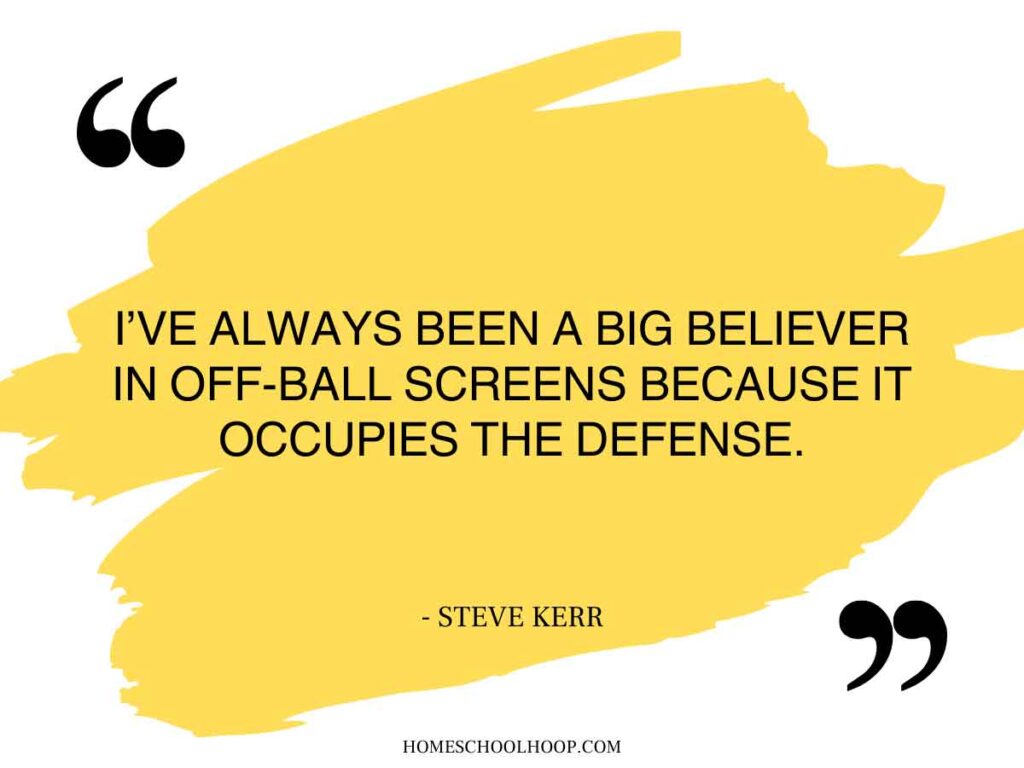
Timing is Everything
Timing can make or break a screen in basketball. The screener should set the screen just as their teammate is ready to cut. Set it too early, and the defense will catch on and easily navigate the screen; too late, and you risk a foul call.
Both the screener and the player using the screen (the cutter) need to know the play and communicate. Sometimes the screener will motion with their hand that they’re coming to signal it’s time to use their screen. Other times, the cutter will give a signal or look to their screening teammate to start the action.
Regular practicing back screens helps teammates get the timing, movements, and on-court communication down.
Positioning for Success
Back screens only work in offensive plays if the players executing them consider their positioning.
- Close, But Not Too Close: The screener should get near enough to the defender to ensure contact, but not so close as to initiate the collision.
- Cutter’s Path: The cutter has to come right off the shoulder of their screener, brushing past them so they set their defender up for a collision with the screener. If they leave too much space between them and the screener, the defender will be able to easily fight around the screen.
Back Screen Plays and Techniques
Most teams incorporate some type of screen in their offensive schemes. Two NBA teams in particular, the Golden State Warriors and San Antonio Spurs, notoriously utilize back screens in their playbooks.
Golden State Warriors: Masters of Moving Without the Ball
The Golden State Warriors are a prime example of using back screens with players off the ball effectively. Here are some of the ways they do it:
- For Open Shots: They set back screens to free up players like Klay Thompson and Draymond Green, often near the rim. These screens catch the defense off guard, creating easy field goals.
- Capitalizing on Lazy Defense: When they notice a less vigilant defense, they quickly set back screens as they bring the ball up, leading to quick layups or dunks.
- Using Stephen Curry’s Scoring Threat: They regularly have Stephen Curry set the back screens for teammates. This is because they know defenders will likely stick to him and not help on the screen or switch off, leaving the cutter free for a pass.
- Post-Timeout Strategy: They often employ an “Iverson” cut followed by a back screen after timeouts. This involves a lob opportunity created by a back screen, usually leading to an assist and alley-oop.
San Antonio Spurs: A Symphony of Motion
Coach Gregg Popovich’s San Antonio Spurs use back screens as part of their fluid offense:
- Motion Offense Integration: They allow players to incorporate back screens into their motion offense, especially when the defense expects a down screen. This creates space for a two-man game between the guard and the post player.
- Sideline Out of Bounds Action: They execute a sideline play where a back screen helps get the ball to a key player in the post. This involves quick passes and well-timed screens for effective post-positioning.
- Timeout Tactics: After timeouts, they often set up a back screen lob. The target player starts at the top of the key and uses a screen from a forward to break free for an alley-oop.
- 1-4 UCLA Seal Play: In this formation, four players line up at the free throw line extended. The point guard initiates the play by passing to the wing and using a back screen to cut to the block. This can lead to an immediate scoring opportunity or a post-up play.
Developing the Skillset for Back Screens
Executing the back screen in basketball is more than knowing the play; it takes having the right skills and physical strength.
Tips for Improving Back Screen Skills
To get better at back screens, players should focus on several key aspects:
- Practice Timing: Work with teammates to practice the timing of your screens during drills. This helps in understanding when to set a screen for maximum effect.
- Work on Stealth: Practice moving into position without drawing attention. The more unnoticed you are, the more effective the screen.
- Learn to Communicate Non-Verbally: Develop signals with your teammates so you can silently communicate when to start a play.
The Role of Core and Lower Body Strength
Strong core and lower body muscles are vital for effective back screens:
- Stability and Balance: A strong core helps you maintain balance while setting a screen, especially when there’s contact.
- Powerful Stance: Good lower body strength allows you to hold your position firmly, even against larger defenders.
- Injury Prevention: Strong muscles in these areas also help prevent injuries that can occur from physical contact during screens.
Exercises like squats, deadlifts, and planks should be a part of your basketball training because they can help you build good lower body and core strength.
Back Screen Drills
Back screen drills can develop and improve a team’s back screen skills. Here are basic team drills that focus on developing players’ abilities to better use back screens.
These basketball drills improve players’ timing, basketball positioning, and team coordination while using back screens. They also enhance their grasp of movement and spacing on the court.
Drill #1: Back Screen Near High Post Elbow
The drill practices setting and using a back screen near the high post area.
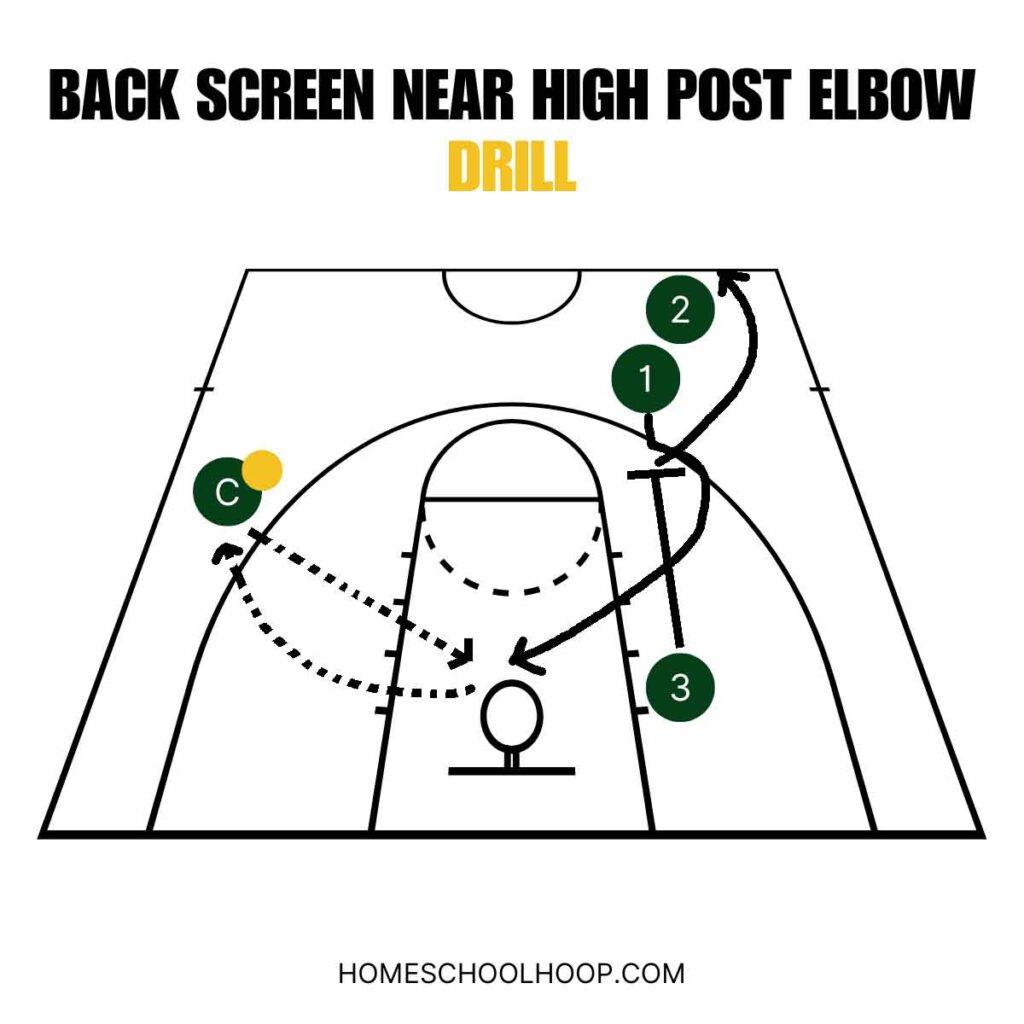
Setup:
- Players line up near the left slot.
- One player stands near the left-side low post area.
- A coach or team manager with a basketball stands near the right side wing.
Execution:
- Player 1 cuts to the basket using a back screen set by Player 3.
- Player 1 receives the ball from the coach and scores at the rim.
- After scoring, Player 1 passes the ball back to the coach and fills the low post area, becoming the next screener.
- Player 3 moves to the back of the line to become the next cutter.
- The drill repeats with Player 2 and so on.
Drill #2: Back Screen Near Mid-Post Extended
This drill focuses on an angled back screen near the mid-post extended area.
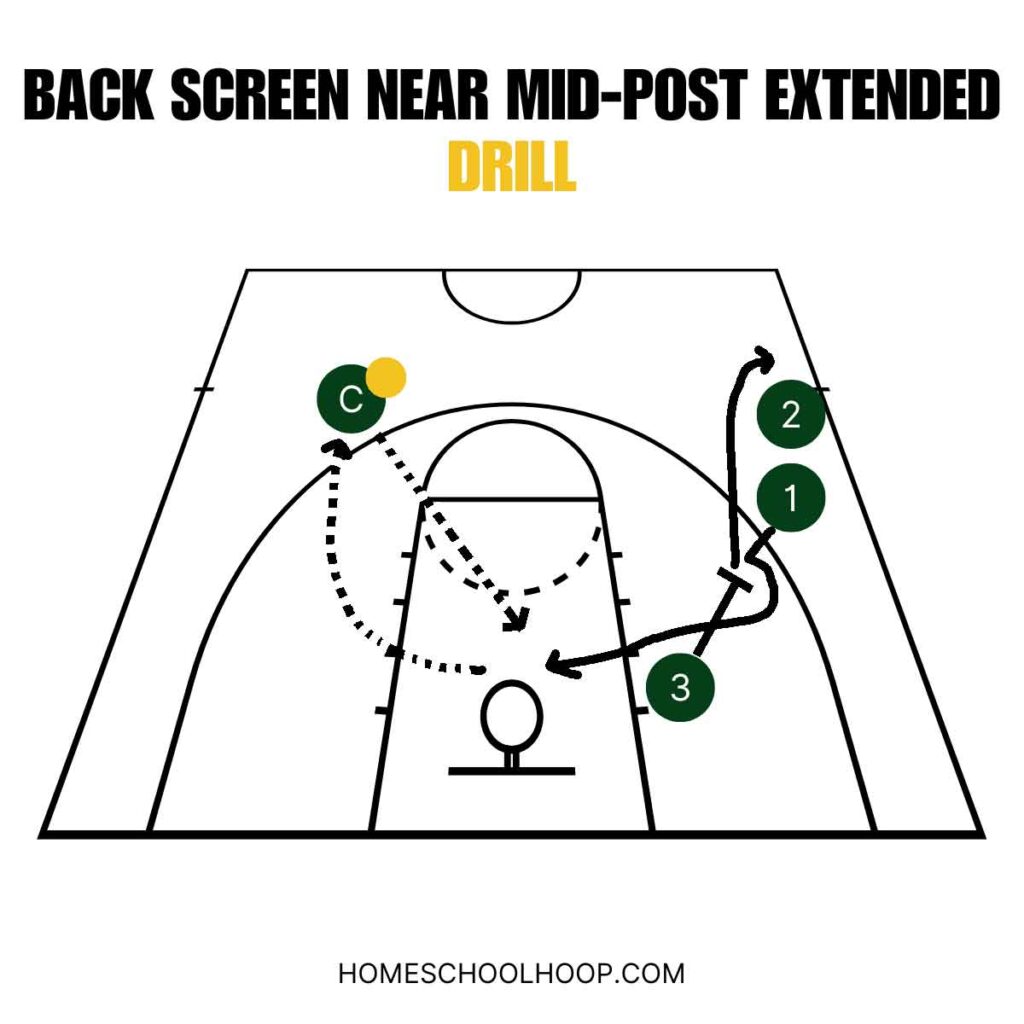
Setup:
- Players line up near the left-side wing.
- One player positions at the left side low post area.
- A coach or team manager with a basketball stands near the right slot.
Execution:
- Player 1 cuts to the basket using an angled back screen set by Player 3.
- Player 1 receives the ball from the coach and scores with a layup or dunk.
- Then, Player 1 passes the ball back to the coach and takes position at the left-side low post, becoming the screener.
- Player 3 moves to the end of the line to be the next cutter.
- The drill continues with Player 2 and follows the same pattern.
Strategies to Counter Back Screens
Defending against back screens requires a mix of anticipation, communication, and smart positioning. Here are some defensive tactics to keep in mind if you expect to face a team that sets back screens.
Anticipating the Back Screen
Staying one step ahead is key in defense; that includes defending back screens. If possible, watch the film of the team you’re playing ahead of time so you have awareness of when to expect screens.
Once it’s game time, pay attention to the offense’s patterns. Teams repeat plays, which can be a cue for an upcoming back screen. Also, always have spatial awareness so you know where your opponents are and when to be ready for a screen.
Communication on Defense
Talking with your teammates when back screens occur is crucial. If you see a screen being set, shout it out to your teammates. This helps your defending teammate being screened to prepare and react.
Being able to efficiently communicate begins before the game. Regularly talk about how to handle back screens in practice, and call out screens during all practices and scrimmages.
Defensive Positioning
Proper body positioning can neutralize the effect of a back screen. If you’re guarding the cutter, keep a distance that allows you to move around the screen but still stay close to your player. Good footwork helps in quickly navigating around screens without losing the player you’re guarding.
Using Team Defense
Guarding a back screen is a team effort. If you’re guarding the screener, separate from your player to create a lane for your teammate to slip through so they’re able to stay with their person. Briefly help cover their player and then quickly get back to your own. And if your teammate gets too caught on the screen, switch defenders with them.
FAQs
What is a back screen in basketball?
A back screen in basketball is when a player sets a screen by standing still behind a defender. This blocks the defender and helps a teammate get free to either receive the ball or take a shot.
Can you screen from behind in basketball?
Yes, you can screen from behind in basketball. This is exactly what a back screen is – setting a screen behind a defender without them seeing it coming.
Can you set a screen with your back?
Yes, you legally use your back to set the screen. You position your back toward the defender and stand still to create a barrier for your teammate to use.
What does back screen mean in basketball?
Back screen means a type of screen where a player stands behind a defender to block them. It’s a strategy used to free up a teammate for an open shot or a better position on the court.
How do you effectively set a back screen?
To effectively set a back screen, choose the right moment when the defense is distracted, move into position quietly behind the defender, and stand firm without moving to avoid a foul.
WHAT DO YOU THINK?
Today, you learned about the back screen in basketball and how it can create open shots near the basket.
So we want to know: In your opinion, which NBA, WNBA, or college basketball team executes the back screen the best?
Let us know which team and why you think they excel at it in the comments.
The TRIVIA answer is Stephen Curry.

